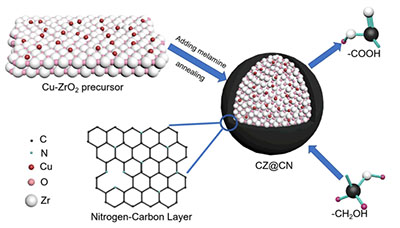摘要/Abstract

本研究以三聚氰胺作为碳源和氮源,经高温热解制得具有核壳结构氮掺杂碳(CN)包覆的Cu-ZrO2(CZ)纳米催化剂(CZ@CN催化剂),并研究了铜与三聚氰胺不同物质的量比对催化剂的影响.采用扫描电子显微镜(SEM)、透射电子显微镜(TEM)、X射线衍射(XRD)、X射线光电子能谱(XPS)、N2物理吸脱附测试(BET)、H2程序升温还原(H2-TPR)等表征技术分析了催化剂的形貌结构及物化性质.考察了催化剂用于二乙醇胺脱氢的催化性能.在铜与三聚氰胺物质的量比为4:1时,制备的CZ@CN催化剂催化活性最高,亚氨基二乙酸钠收率达92.8%,与普通CZ催化剂相比,反应时间缩短了40%,催化剂重复使用8次后收率依然达到88.4%.结果表明,适度的CN层的引入使催化剂具有更多的Lewis碱性位,在脱氢反应中有利于羟基的活化及氢的转移.同时CN层还可以稳定铜纳米颗粒,提高催化剂稳定性.
关键词: Cu-ZrO2, 二乙醇胺, 亚氨基二乙酸, 氮掺杂碳, 催化脱氢
Glyphosate is one of the most widely used herbicides in the world. Current production of glyphosate starts with iminodiacetic acid (IDA). One method of producing IDA starts with the catalytic dehydrogenation of diethanolamine (DEA) using Cu-ZrO2 (CZ), which is a fairly simple, pollution-free, and cost-effective process. The Cu-ZrO2 catalysts used in this dehydrogenation are fairly efficient and inexpensive, but they tend to agglomerate and inactivate. The development of highly efficient and stable Cu-ZrO2 catalyst is of great significance. Carbon coated nano-metal particles are a new type of nano-carbon/metal composite materials. Metal materials can be imparted in a small space due to the surface acidity and alkalinity of carbon coated materials and their unique structural characteristics, which is of great significance for the dispersion and oxidation resistance of the loaded nano-metal materials. In this study, melamine was used as a carbon source and a nitrogen source to prepare a Cu-ZrO2 nanocatalyst (CZ@CN catalyst) coated with nitrogen-doped carbon (CN) with core-shell structure. The effect of different molar ratios of copper and melamine on the catalyst was studied. Scanning electron microscopy (SEM), transmission electron microscopy (TEM), X-ray diffraction (XRD), X-ray photoelectron spectroscopy (XPS), N2 physical adsorption and desorption test (BET), H2 temperature-programmed reduction (H2-TPR) were used to investigate the morphology and structure of the catalyst. The catalytic performance of the catalyst for the dehydrogenation of diethanolamine was investigated. When the molar ratio of copper to melamine is 4:1, the prepared CZ@CN-1 catalyst has the highest catalytic activity. The yield of sodium iminodiacetic acid is 92.80%, and the reaction time is shorter than that of ordinary CZ catalyst by 40%. The yield of sodium iminodiacetic acid still reaches 88.45% after reusing 8 times. The results showed that the introduction of the CN layer makes the catalyst exhibit more Lewis basicity. Meanwhile, it is beneficial to the activation of hydroxyl groups and the transfer of hydrogen in the dehydrogenation reaction. The CN layer can also stabilize copper nanoparticles and improve the stability of the catalyst.
Key words: Cu-ZrO2, diethanolamine, iminodiacetic acid, nitrogen-doped carbon, transfer dehydrogenation
PDF全文下载地址:
点我下载PDF
